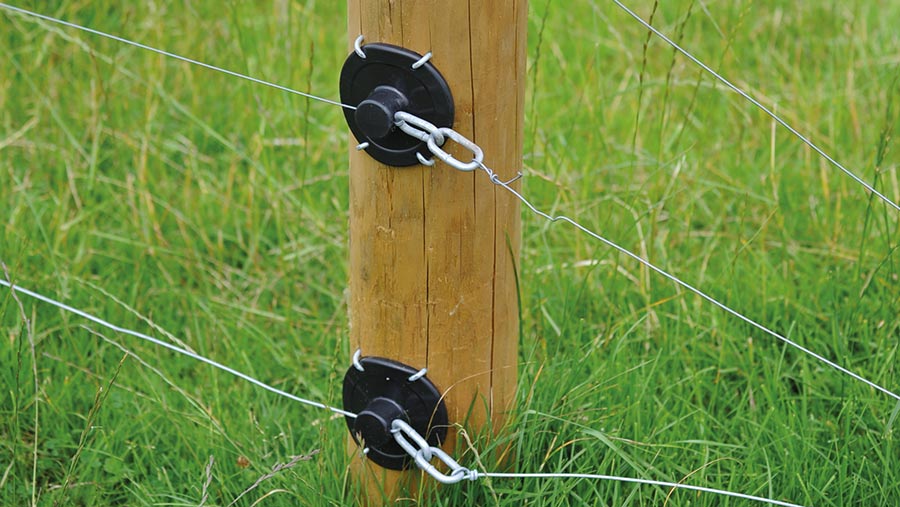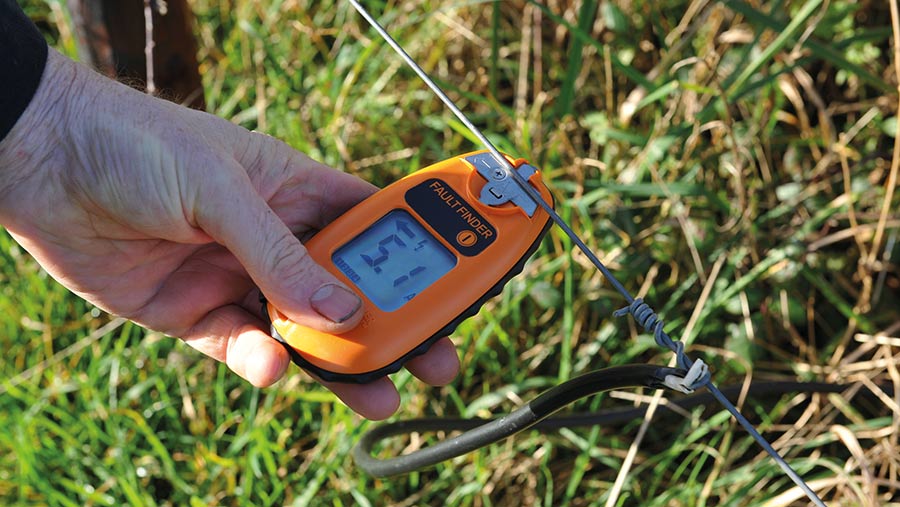Guide to ensuring electric fences are stockproof
 © Debbie James
© Debbie James Checking electric fence systems for faults should be a priority ahead of spring turnout to make paddocks and fields secure.
From testing the flow of electricity to locating where overgrown hedges or fallen branches are tripping the system, checks now will prevent breakouts once stock are at grass.
Fencing expert Mark Oliver of Gallagher offers his tips on what to look for.
See also: Tips to get the perfect solar-powered electric fence setup
1. Check for causes of voltage loss
Vegetation or rust on the fence line are the most common causes of voltage loss.
Energisers, which convert the power from mains or battery to electrical pulses, can lose voltage if enough weeds or grass touch the fence, especially when wet.
Rust on the fence wire acts like an insulator and will not transfer the shock to the animal.
To avoid this issue, spray under the fence line with herbicide or strim under the bottom strand of wire.
Drag a long stick along the ground beneath the bottom strand as you walk the fence line to knock away any hidden objects that may be interfering with the fence.
2. Check conductors, insulators and fencing posts
A short can occur when the power escapes to the ground because of a broken wire, insulator or underground cable, or a loose connection.
Listen for the rhythmic snap that indicates a voltage leak; follow your ears to find the source.
A broken insulator can allow the fence strand to touch the post.
This is not an immediate problem with a non-conductive wooden post, but if you’re using steel posts a broken insulator can cause the fence to short when the strand touches the metal.

© Debbie James
Look carefully where cables run underground, at gates and corners in runs of fencing, and where the fence comes close to other fences.
A ground fault can also occur when metal staples dig through plastic insulators. When this happens, the staple contacts the electric fence wire and provides a conduit to the wooden post.
To fix, replace the damaged insulators with heavier-duty screw-in ones.
3. Check all the remaining components
Check if any of the remaining components such as gate handles or connectors need to be replaced to ensure the fence is functioning at its optimum.
Ground-rod wires can get knocked or kicked away and wires attaching the cable to the fence may come loose.
Look for frayed spots in poly tape because if metal fibres in the weave become separated, the tape can’t conduct current.
4. Check the earthing
About 90% of electric fencing faults are caused by insufficient earthing.
To check for a faulty earth, connect the energiser to the fence and to the earth system and switch on the power source.
Simulate a large fault on the fence, such as resting a branch on the wire.
Check the measurement on the fault finder. If the reading is below 300V then the earth is working with the current load on the fence. If it is greater than 300V the problem lies with the earth.
To rectify the earth fault, fix any joint or cabling issues; if that doesn’t work, put the earth or ground stakes into more conductive soils, or add more earth or ground stakes.
5. Is the energiser working correctly?
Use a fence tester to establish how well the energiser is working without any other variable.
If the voltage reading is higher than 5,000V it is working as expected, but if the voltage is less than 1,500V, or there is no voltage, there is a problem with the energiser.
If the voltage is greater than 6,000V, then the problem lies with the fence.
Steps to finding a fault on the fence line
If the energiser and the earth are working correctly, the next step is to search for a fault on the fence line itself. This can be done using a fault-finding device.
It helps to know what the voltage and current on the fence line are when the system is performing effectively. This will vary between farms, and even between fields on a single farm.
To check for faults on your fence line, use the reading for amps rather than volts on the fault finder.

© Debbie James
To find a fault, follow the flow or the electrical current. In general, the bigger the reading, the worse the fault – but the length of the fence and what’s normal for that fence need to be considered.
Soil type, number of wires and vegetation load can also affect the reading. A rule of thumb is about 2.5A/km of fence, although what is normal for your field or farm may be much higher or lower than this.
To use the fault finder:
- Choose a point on the fence close to the energiser and take an amp reading. If it is a multi-wire fence, you will need to check all the wires
- Follow the direction of the arrow on your fault finder to follow the current of your fence
- Walk the fence line, checking it at regular intervals, for example, every 100m, and at every junction point. When the current load drops off you have passed the fault
- To find less obvious faults, such as a broken insulator, walk the fence line at short intervals to find where the current drops off
- When the fault is found, turn the power off and repair it
- When the repair is complete the power can be turned back on via the energiser, the cut-out switch or by using the remote control
- Test the fence to see if the voltage has returned to what is normal for that system
- If it has not, continue following the current to find the source of the problem.
Buyer’s guide to fault finders
Gallagher fault finder voltage and current meter
This fault finder simultaneously measures the current flow and voltage and follows the current flow to detect a fault.
It can be used on any type of electric fence, from a single wire to a multi-wire installation.
Price: £146.25 including VAT
Pasturetec Rutland Digital Fence Tester
This device measures up to 9,900V and comes with a ground spike and a durable plastic case and belt pouch.
Price: £34.38 including VAT
Rappa Remote Fault Finder
This device has the added ability to switch the fence energiser on or off from any location to allow maintenance or repairs to electric fencing to be carried out.
It has 15 different channels to avoid interference from neighbouring electric fences.
Price: £226.71 including VAT
Agrisellex Fault Scout
This digital voltmeter has a built-in ammeter and indicates fence voltage, current and current direction.
Price: £138 including VAT
